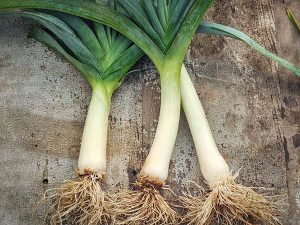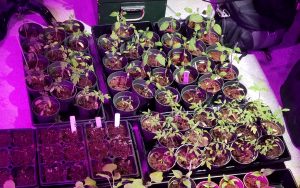Leek
What is a Leek
The leek (allium porrum), a mild flavored member of the onion family, is a hardy biennial grown as an annual in the vegetable garden. However; unlike onions and shallots, leeks do not bulb, they are straight stalk plants. They are grown for their thick, juicy, mild flavored stems. The edible part being the lower stem.
 If left in the garden, and if they survive winter weather, they will flower in year two and go to seed, as does parsley.
If left in the garden, and if they survive winter weather, they will flower in year two and go to seed, as does parsley.
The top growth of leeks (the leaves), called the flag, are thick and strap like and are colored green to dark blue-green. The top growth does not die back as the plant matures.
Leeks contain the following vitamins and minerals:
Vitamins – Vitamin A, Thiamine (B1), Riboflavin (B2), Niacin (B3), Pantothenic acid (B5), Vitamin B6, Folate (B9), Vitamin C, Vitamin E, Vitamin K
Minerals – Calcium, Iron, Magnesium, Manganese, Phosphorus, Potassium
Leeks can require a long growing season—up to 170 days. They grow best in cool, mild weather.
They require little to no attention and are generally pest-free. In the kitchen, they can be substituted for onions. Leeks can be chopped and frozen for later use.
Types of Leeks
There are two types of leeks: short-season (non-hardy)and long-season (hardy).
Short-season leeks, also known as summer leeks, have thin stems. They mature in about 60 – 90 days and are harvested during the summer and early fall. They can be harvested and used like scallions when young. Summer leeks are not winter hardy and do not store as well as long-season leeks. Good varieties of summer leeks are:
Alto Leek early summer – High Mowing Seeds
King Richard Leek – High Mowing Seeds
Chinook Leek – Territorial Seed Company
Long-season leeks, also known as winter leeks, have thick, cylindrical stems. They take about 100 – 170 days to reach harvest. Long-season leeks are harvested late summer through the winter. They store well either inground or in cold damp sand. Good varieties of winter leeks are:
Bandit Leek – High Mowing Seeds
Tadorna Leek – High Mowing Seeds
American Flag – Ferry Morse
Where to plant
First, if you can, you should rotate the location of where you grow your vegetables – and that also includes leeks. Try to move them to a new bed to avoid sections where they, onions or garlic have grown in the past year. This helps avoid the pests and diseases that can cause problems or ruin the crop.
Leeks like full sun, however, they do tolerate partial shade. Plant in well-drained soil rich organic soil with a pH of 6.0 to 6.8.
When to plant
Winter leeks take up to four (4) months to mature, if you live above zone 7, you should sow your winter leek seeds indoors in early spring. Start the seeds indoors about 2 – 3 months before the last expected spring frost – check the Plant Hardiness Zone Map
Transplant seedlings into the garden as early as 1 to 2 weeks before the last expected spring frost. Leeks should be in the garden no later than early summer for autumn harvest. They will survive light frosts even when young — and heavy frosts in the fall.
If you live in planting zone 7 and warmer, you can plant winter leeks directly into the garden about the time of the last expected spring frost.
Summer leeks can be sown directly into the garden about the time of last spring frost dates.
Unused seeds can be kept up to 3 years.
How to Plant
First, mark your rows and remove the top 6 inches of soil in each row to create trenches. Space leek transplants 6 inches apart when planting. They grow best in temperatures between 55° and 75°F. Growth will be slowed by hot weather. Planting beds should have well-aged manure and compost.
Sow leek seeds ½ inch deep. They typically germinate in 10 to 14 days at 70°. When the seedlings reach about 8 inches, thin to 4 to 6 inches apart. Rows should be spaced 12 to 16 inches apart. Stagger the plants in each row so they are not uniform, this will allow the plants more room to grow.
As the plants grow you will need to use the removed soil to back-fill around the stems (you may fill in 2 -4 times during the growing season). This will blanch the lower stems that get covered. Blanched stems will be white and tender. Another way to blanch stems and avoid playing with dirt is to use leaves and grass clippings. I tried this in 2020 and it worked fine – it also kept the plants dirt free.
Plant Care
If you start your leeks indoors keep the tops trimmed to about 4 inches tall to encourage stocky stem growth. When the weather is good, transplant into the garden.
Keep the soil around leeks evenly moist; water when the surface becomes just dry. Feed plants with compost tea or worm tea every four weeks during the growing season. If using normal fertilizing methods, you should spread 5-10-5 fertilizer every 3 to 4 weeks at a rate of 5 ounces of fertilizer per 10 feet of row.
Soil that tumbles into leaf folds can wind up trapped between skin layers in the stem. To keep this from happening you can slip a section of paper tube, such as from toilet tissue or paper towels, over the plants while they are still young as early as planting time. The tube will rot over the growing season but will help prevent soil from getting into leaf bases during early growth.
The closer together you plant leeks, the smaller they will be. Commercial growers usually place them about 6-8″ apart and don’t thin them. A good technique for home gardeners is to plant them just 2-3″ apart and achieve proper spacing by harvesting leeks as you need them. These young leeks are a good substitute for green onions in the kitchen.
After planting, mulch the bed with straw (I hate Straw) or other organic material (try shredded paper) to help soil retain moisture. Water plants as needed until they are established. Plants require an inch of water a week, either through rainfall or irrigation. Inconsistent moisture may cause tough stems.
Pests
On young plants, slugs can be devastating. Gather them at night, set traps, or use biological control.
Diseases
If there is a lot of rain in winter or early spring, leaf rot can set in. Rot shows as white spots on leaf tips that eventually shrivel. At this point there is not much you can do except pull the rotted plants and thin the planting to increase air circulation.
In summer orange pustules on leaves indicate leek rust, which is worse in wet growing seasons. Remove affected foliage; later maturing foliage will be healthy
Harvesting
You can pull leeks any time. Typically, you want them at least 1 inch or larger in diameter, but you can dig young ones to eat like green onions / scallions. Leeks have large root systems so use a hand fork or garden fork to loosen the soil before lifting the plants. A 10-foot row can yield up to 15 to 20 mature plants.
In colder areas, extend the harvest season by mulching deeply around plants (up to 1 foot deep). You can continue harvesting leeks but when a hard freeze is expected dig them up.
In zones 7 and warmer, you should be able to harvest leeks all winter long.
Storing
Initially, when harvesting leeks, shake and brush off as much soil as possible then rinse the plant thoroughly. To freeze leeks, wash, slice, and blanch for 1 minute in boiling water. Drain, drip dry, and toss into plastic freezer bags.
Store leeks wrapped in a damp paper towel in a perforated plastic bag in the refrigerator for 7 to 10 days. Smaller leeks store better than larger leeks. Trim the roots and wash the leaves and stem before refrigerating.
For longer storage in coldest zones, dig leeks with roots attached. Cut leaves back until just an inch of green remains on each leaf. Place stems in a box (root side down) and pack with sawdust, clean sand, or vermiculite. Keep the packing moist and store in a cool place. Stems will keep up to 8 weeks
 e. I fight the pests and weeds as organically as possible. When the garden starts to produce and we eat the first tomato or pepper, knowing it is clean of harmful synthetic chemicals is comforting. Also knowing the food came from 200 steps away and not 2,000 miles away along with the associated costs is well, rather satisfying.
e. I fight the pests and weeds as organically as possible. When the garden starts to produce and we eat the first tomato or pepper, knowing it is clean of harmful synthetic chemicals is comforting. Also knowing the food came from 200 steps away and not 2,000 miles away along with the associated costs is well, rather satisfying.